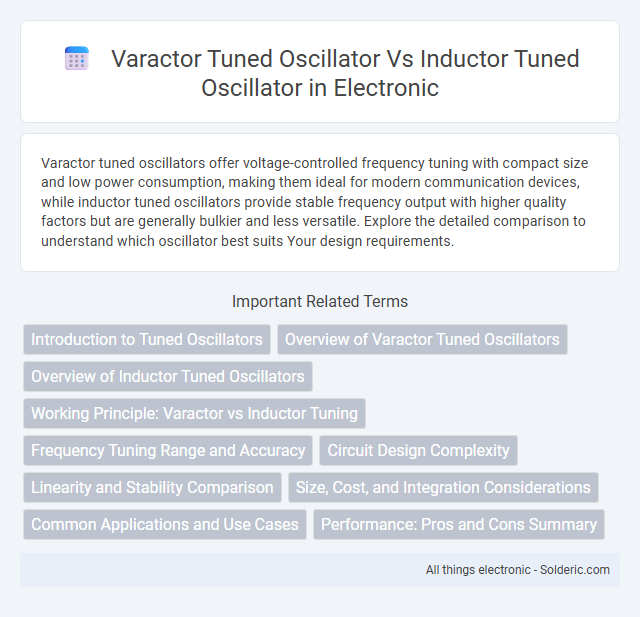Varactor tuned oscillators offer voltage-controlled frequency tuning with compact size and low power consumption, making them ideal for modern communication devices, while inductor tuned oscillators provide stable frequency output with higher quality factors but are generally bulkier and less versatile. Explore the detailed comparison to understand which oscillator best suits Your design requirements.
Comparison Table
| Feature | Varactor Tuned Oscillator | Inductor Tuned Oscillator |
|---|---|---|
| Tuning Element | Varactor diode (voltage-controlled capacitor) | Variable inductor (coil) |
| Tuning Range | Wide frequency range, high agility | Narrow frequency range, limited agility |
| Size | Compact, suitable for integrated circuits | Bulky, less suitable for IC integration |
| Frequency Stability | Moderate; influenced by varactor non-linearity and temperature | High; more stable with less drift |
| Tuning Speed | Fast electronic tuning via voltage control | Slow mechanical tuning |
| Power Consumption | Low | Typically higher due to mechanical components |
| Cost | Low to moderate, cost-effective in mass production | Higher due to inductors and mechanical parts |
| Applications | RF circuits, phase-locked loops, frequency synthesizers | Low-frequency oscillators, audio circuits, precise tuning |
Introduction to Tuned Oscillators
Tuned oscillators generate stable frequency signals by using reactive components to select the oscillation frequency. Varactor tuned oscillators employ voltage-controlled capacitors (varactors) to adjust the frequency dynamically, offering fine-tuning and frequency agility in RF circuits. Inductor tuned oscillators rely on fixed inductors paired with capacitors, providing robust frequency stability but limited tunability compared to varactor-based designs, making your choice critical depending on application needs.
Overview of Varactor Tuned Oscillators
Varactor tuned oscillators (VTOs) utilize varactor diodes whose capacitance varies with applied voltage, enabling precise frequency tuning over a wide range. This voltage-controlled tuning mechanism offers higher linearity and lower phase noise compared to inductor tuned oscillators, which rely on fixed inductors and variable capacitors. Your application benefits from VTOs' compact size, faster tuning response, and improved stability in high-frequency communication systems.
Overview of Inductor Tuned Oscillators
Inductor tuned oscillators utilize inductors paired with capacitors to establish a resonant tank circuit, determining the oscillation frequency through inductive reactance. These oscillators exhibit stable frequency characteristics and are commonly employed in RF applications where low phase noise is essential. While they offer robust performance, inductor tuned oscillators often face challenges such as larger component size and limited tuning range compared to varactor tuned oscillators.
Working Principle: Varactor vs Inductor Tuning
Varactor tuned oscillators control the oscillation frequency by varying the reverse bias voltage applied to a varactor diode, which changes its capacitance and thus tunes the resonant frequency of the LC circuit. In contrast, inductor tuned oscillators adjust the frequency by mechanically or electromagnetically varying the inductance in the circuit, often using variable inductors or tunable magnetic cores. Varactor tuning provides faster, electronically controlled frequency adjustments with higher precision, whereas inductor tuning typically offers wider tuning ranges but slower and less precise frequency changes.
Frequency Tuning Range and Accuracy
Varactor tuned oscillators (VCOs) offer a wider frequency tuning range due to the voltage-controlled capacitance of the varactor diode, enabling fine frequency adjustments ideal for applications requiring broad tunability. Inductor tuned oscillators typically provide higher frequency accuracy and stability because of the fixed inductance and minimal susceptibility to voltage variations, making them suitable for precision frequency generation. Your choice depends on whether a broad tuning range or superior frequency precision is the priority in your oscillator design.
Circuit Design Complexity
Varactor tuned oscillators exhibit increased circuit design complexity due to the need for precise voltage control and compensation for non-linear capacitance variations. In contrast, inductor tuned oscillators offer simpler circuit designs with more stable frequency control but require careful inductor selection to minimize losses and parasitic effects. The integration of varactors demands advanced biasing networks and temperature stabilization, making their design more challenging compared to inductor-based oscillators.
Linearity and Stability Comparison
Varactor tuned oscillators provide superior frequency stability due to voltage-controlled capacitance, allowing precise tuning with low phase noise. Inductor tuned oscillators offer inherent linearity in frequency response but suffer from greater drift caused by temperature variations and component aging. Varactor oscillators deliver enhanced linearity over a wider tuning range, whereas inductor tuned oscillators excel in scenarios demanding high Q-factor and minimal signal distortion.
Size, Cost, and Integration Considerations
Varactor tuned oscillators typically offer smaller size due to the integration of varactor diodes on-chip, enabling compact and monolithic circuit designs, whereas inductor tuned oscillators require bulky inductors that increase overall footprint. Cost-wise, varactor tuned oscillators often have lower manufacturing expenses because they avoid expensive inductors and facilitate mass production on semiconductor substrates. Your choice should consider integration needs, as varactor tuned oscillators seamlessly match with IC technology, improving reliability and reducing parasitics compared to the discrete components necessary in inductor tuned oscillators.
Common Applications and Use Cases
Varactor-tuned oscillators (VTOs) are widely used in frequency modulation (FM) radios, voltage-controlled oscillators (VCOs) for phase-locked loops (PLLs), and tunable microwave communication systems due to their precise frequency control and compact design. Inductor-tuned oscillators (LTOs) are commonly found in low-frequency signal generation, RF transmitters, and local oscillators for receivers where higher quality factors (Q) and stability are crucial. VTOs excel in integrated circuit implementations for agile frequency synthesis, while LTOs are preferred in applications demanding minimal phase noise and robust performance under varying temperature conditions.
Performance: Pros and Cons Summary
Varactor tuned oscillators (VTOs) offer superior frequency tuning range and low phase noise, making them ideal for compact, integrated circuits in RF applications. Inductor tuned oscillators (ITOs) typically provide higher Q-factors, resulting in better signal stability and lower power consumption but often suffer from limited tuning range and larger physical size. VTOs excel in tunability and integration, while ITOs are preferred for stability and low distortion in fixed-frequency scenarios.
Varactor tuned oscillator vs Inductor tuned oscillator Infographic

 solderic.com
solderic.com